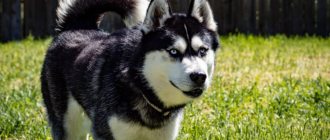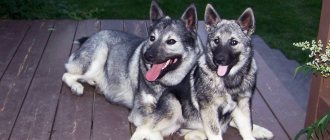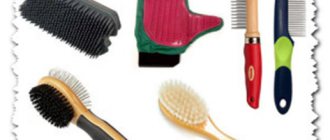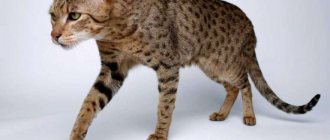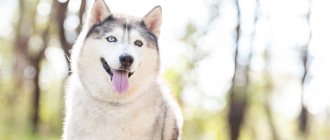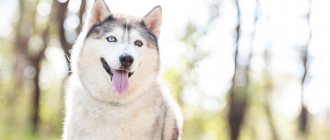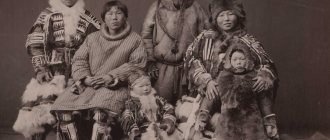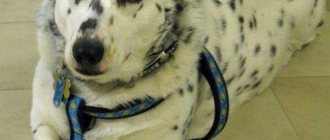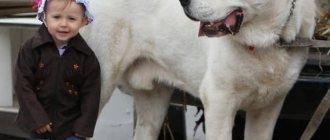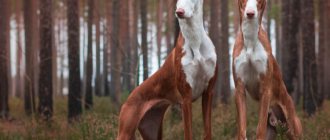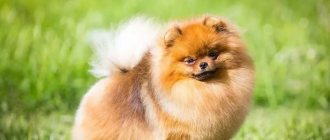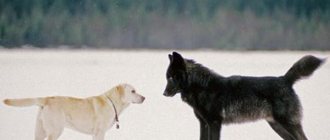When it comes to sled dogs, pictures with reindeer herders, sleds and sleighs against the backdrop of northern landscapes are traditionally recalled. Fluffy “horses” are unusually playful and hardy. They withstand harsh winters well and are capable of transporting cargo over long distances. Few people know that sled dogs can even be used to tow small watercraft.
Sled dogs are unusually fast and hardy
Sled dogs that are included in the FCI register (5 group, 1 section)
According to the unified classification of dog breeds adopted by the International Federation of Cynologists (FCI), sled dogs belong to the list of northern and primitive (aboriginal). The breed diversity approved by this organization is not exhaustive, since not all of the existing varieties of sled dogs are officially recognized. Next we will talk about animals registered by the FCI.
Photo from the Anchorage History Museum (Alaska)
Alaskan Malamute
These dogs come from the coast of Alaska. The local population - Malamutes who lived along the shores of Kotzebue Bay - traditionally bred them for household needs. They led a nomadic life, so they chose the hardiest dogs to help them. Considering that animals lived next to humans, it was important that they were not aggressive. For this reason, Alaskan aborigines preferred dogs with a stable psyche and even character.
Alaskan Malamute
The isolation of the Malamute's habitat favored the fact that foreign blood was not used in breeding dogs. This made it possible to preserve the animals’ exterior unchanged. During the Gold Rush, a flood of prospectors poured into Alaska. They appreciated the quality of local dogs, and then decided to improve their speedy qualities, for which they began to breed with representatives of other breeds. This has led to a decline in the number of purebred animals.
Today, Alaskan Malamutes are considered the largest of all the variety of sled dogs. A mature animal can weigh up to 45 kg and have a height of up to 65 cm. The dogs have a characteristic color similar to a wolf, as well as thick fur, consisting of two layers. They are physically hardy, have a wayward character, and are selflessly devoted to their owner.
The pet is almost as big as its owner
The Alaskan Malamute is a wonderful dog. Read our article and you will learn about the rules for keeping, raising and training dogs of this breed.
Modern Malamutes are represented by two lines:
- Kotzebues, who are externally and genetically closer to their wild ancestors, have a rather harsh temperament, and outwardly resemble a large and strong wolf.
- Mluts are a branch of Malamutes with excellent show characteristics. Such dogs can often be seen at shows. Kennels are happy to breed them, since Mlut dogs are in good demand among experts. A peculiarity of animals of this branch is a wide palette of coat colors - from white-blue to dark gray.
Kotzebue and Mlut
Malamutes are exclusively sled dogs because they cannot perform any other functions, that is, they do not make guards or hunters. Dogs are friendly to humans, but peace with other pets is only possible when they do not claim leadership.
Malamutes can be kept in a city apartment, but this is very difficult. They need to be walked daily and given good exercise. In addition, it is worth considering that Malamutes are pack dogs; they cannot stand being alone, so a long absence of the owner is undesirable.
Greenland sled dog (Greenlandshound)
There is no exact information about the origin of this breed. There is an assumption that the ancestors of Greenlandshunds lived in the vastness of Siberia and were the result of crossing aboriginal dogs with Arctic wolves. Only in the XVII century they were brought to Greenland. Today, the number of these dogs is small even in Scandinavian countries, where working breeds are traditionally popular.
Adult animals grow up to 64 cm at the withers and gain up to 32 kg of weight. They obey exclusively the owner, and then only in cases where human commands do not contradict the mood of the animal. Greenland sled dogs are not prone to escape, like huskies, for example. They know how to transport cargo, as well as protect the space they consider theirs.
The Greenland dog looks like a wild animal, and not only in appearance. These dogs are not inclined to bark, but they often howl, like their ancestors. This is how they demonstrate unity with the pack.
White and brown harp dog on a walk
Given its character, the breed is not recommended for inexperienced owners, or for keeping in an apartment. These pets must get tired, but regular games and short runs are not enough for them. Greenland dogs love towing an adult skier, as well as a cyclist or other load.
These dogs need constant exercise
Siberian Husky
These are the favorite dogs of the Chukchi. Representatives of northern peoples adopted huskies earlier than deer, and consider these dogs not just animals, but full members of the family, which is understandable. In the harsh climate of the Far North, where temperatures drop to -60°C, animals have traditionally helped and continue to help people survive. They were harnessed to teams to ride or transport goods. And on long winter nights, huskies worked as heaters - they slept with people, saving the owner's family from the cold with the warmth of their bodies. When a baby was born, dogs were invited to the tent so that they could get to know the newborn. Smart and beautiful huskies are still often used as a nanny. They cope well with this role, providing the baby with interesting leisure time and supervision.
Externally, “Siberians” resemble Malamutes, but are smaller in size. The height of an adult animal is up to 60 cm at the withers, and its weight is up to 28 kg. They have an athletic build, dense double-layer coat and an easy gait.
Siberian Husky with blue eyes
The husky's character is calm and friendly, its temperament is lively. They are unsuitable for hunting, that is, they are capable of hunting animals, but do not bring prey to the owner. They make unimportant guards because the dogs are not aggressive towards humans, and they have almost no guard instinct. The dog is too independent, which is why it is not suitable for the role of a service dog.
Keeping a Husky at home presents certain difficulties due to its activity, constant need for movement, as well as physical activity. These dogs are prone to escape, so even when living on the territory of a country house, they periodically make tunnels in order to go on an independent journey.
Husky in harness
Samoyed (Samoyed Laika, also known as Samoyed Spitz)
Representatives of the breed received such an unusual name from the northern tribe of nomads - Samoyeds - one of the peoples of the Sami group. Dogs were traditional companions of people and were used as a means of transport, for security purposes and for hunting animals. Huskies gained particular popularity at the end of the 19th century, when the British scientist Robert Scott, who was studying the polar territories, attracted the attention of the whole world to the hardy and beautiful dogs that easily transported heavy loads over long distances. The breed was liked and loved, and Samoyeds have since been actively bred.
Samoyed team
There are two types of dogs of this breed:
- bearish - with a powerful, short body and wide head;
- wolf - with an elongated body and a narrow skull.
"Wolf type" Samoyed
According to the standards, Samoyeds grow up to 60 cm at the withers, and their weight ranges from 18 to 30 kg.
Their “signature” sign is a cheerful “smile”, which makes their appearance optimistic and cheerful. Another feature of these dogs is the tip of their nose. It can be black, brown or light beige, but in winter it can lose color.
The Samoyed Laika is a hardy worker, delicate and perfectly understands people. This dog has a cheerful and friendly, but at the same time independent character. She is distinguished by good intelligence and boundless devotion, gets along well in the family and finds a common language with children. The Samoyed is not aggressive, not timid and not cowardly. It can be used as a watchdog or guard dog. His hunting instincts are weakly expressed, which means that the animal will not become a threat to other pets.
The Samoyed's famous "bear" smile
Representatives of the breed are energetic and love life in nature, so they do not tolerate being kept indoors. They are not suitable for chains and kennels; they like to run and “work” a lot. Samoyeds cope well with loads twice their own weight. Only Malamutes can boast of such endurance. Among other things, Samoyed dogs have an incredible sense of danger. They “see” cracks and holes under the snow and easily find their way home in the most difficult situations.
Where to buy puppies, how much can they cost?
There are kennels in Russia where sled dogs are bred. Here they can be purchased with a pedigree and the necessary certificates. Additionally, breeders will provide recommendations on the care and maintenance of the pet. The average cost of Samoyed, Siberian Husky, Malamute puppies is from 25 to 40 thousand rubles. Elite babies cost 50-100 thousand rubles.
Samoyed puppies
Nurseries of Yakut Laikas are rare. They are in Yakutia and large cities of the European part of the Russian Federation. There is growing interest in this breed among foreign dog breeders. The cost of a puppy with a pedigree is 10-30 thousand rubles. There are no nurseries in Russia where Greenland sled dogs are bred. Buying a Greenlandshound puppy is very difficult, since babies that are weak and unsuitable for survival are discarded immediately after birth. For this reason, the number of animals in the world is small.
Kennels sell puppies of sled breeds at the age of 2–2.5 months. When purchasing, you should check your passport, pedigree and vaccination certificate. If an animal is purchased as a companion, you should pay attention to pet-class puppies. If you want to raise a pet for work and hunting, you should purchase offspring from working parents, who will pass on the necessary skills by inheritance.
join the discussion
Share with your friends
Just a century or a century and a half ago, most dog breeds had a specific purpose - some were used for hunting, others herded herds, and others were useful only as decorative ornaments. Today the situation has changed - representatives of most breeds are kept at home simply as pets. If you decide to get yourself an unusual purebred dog, pay attention to the sled dogs that are becoming increasingly popular. At the same time, home breeding of such dogs outside the far North is not yet very common, so the topic deserves more detailed study.
Sled breeds that have not received recognition, mixed, developing.
Having dealt with the breeds included in the FCI documents, we cannot help but say about those that are not yet officially recognized, but have brilliant prospects in this regard.
Alaskan Husky
Indigenous representatives of the aboriginal fauna with “wild” ancestors. They differ from their Siberian relatives in character and smaller dimensions. The breed was formed naturally, without human intervention. The dogs turned out to be strong, hardy, and also unpretentious, because individuals with poor health and constitution died in harsh climates. Today, Alaskan huskies are considered perhaps the fastest sled dogs. Despite the temporary lack of official status, the breed is very popular in the United States.
The Alaskan Husky resembles its Siberian counterparts in appearance.
Sakhalin Husky (Karafuto-Ken, also known as Gilyak Laika)
This domestic variety of mounts, which, oddly enough, is popularized by Japanese cynologists, was created for use for transport purposes, but thanks to courage and fearlessness, they began to be used by hunters for hunting animals.
If not for the donut tail, it would be an almost white wolf
Chinook (Chinook sled dog)
Representatives of this breed are large dogs (up to 45 kg in weight and up to 75 cm in height). They have well-developed bones and muscles, excellent health, and a calm temperament. Chinooks are used for riding and transporting goods, and in terms of running speed they are only slightly inferior to the recognized champions - huskies. If you keep a dog properly and raise it correctly, you can grow it into a friend and a guard, so docile and versatile are the representatives of this breed.
Hardworking Chinooks
Norwegian sporting mixed breeds (Greysters)
Dogs of a special breed, in the formation of which German shorthaired pointers and pointers, as well as greyhounds, took part. Mestizos were bred exclusively to participate in racing competitions. The animals performed well in competitions in skijoring (cross-country skiing) and bikejoring (towing mountain bikes).
The winning team
Wolfdog
This is the name given to mixed breeds obtained from the mating of a German shepherd and a wild wolf. They are used as mounts and guards. The first generations of puppies were distinguished by an unstable psyche and corresponding behavior. Breeding wolf-dogs is an attempt by domestic biologists to create a dog with universal service characteristics. However, most of the offspring remained in the ownership of the breeders. Some individuals were rented (not sold!) for official purposes.
Until now, it is impossible to officially acquire the offspring of wolfdogs.
This is what a wolfdog looks like - a service dog of wolf origin
Wolf dogs during the race
Eskimo Husky
One of the varieties of northern sled dogs. Representatives of the breed are strong, hardy, and almost never bark. The homeland of the Eskimo husky is Eastern Siberia. In the 20th century, dogs became popular in Alaska and Greenland. Nature has endowed these dogs with a stern character and courage, so the “Eskimo” can not only transport cargo, but is also an excellent watchman, as well as a reliable hunting assistant.
Eskimo Husky
Yakut Laika
An old breed of dog from Northeast Russia. Yakut dogs are universal. Like some other sledding breeds, they cope with transport tasks, and also have hunting and guard qualities. Yakut Laikas are distinguished by their sharp mind and sociable character, they sincerely become attached to a person and serve him with great diligence.
The Yakut Laika is not afraid of harsh winters
This is not a complete list of sled dogs, whose working abilities people have long appreciated and successfully use. Despite the fact that the dogs are not yet recognized by the Fédération Cynologique Internationale, many breeders and dog handlers believe that it is just a matter of time.
Team of Yakut Laikas
Description of Norwegian mestizos
Norwegian mixed breeds, like other sled dogs, are socially oriented animals. It is not for nothing that from generation to generation individuals who show the slightest aggression towards their relatives have been swept aside. In addition, from puppyhood they get used to obeying their owner, because sled dogs already have a pack in which the leader is the athlete. They simply adapt to the existing hierarchy.
Norwegian mixed breeds are divided according to the distances at which they can work. This separation is not carried out at birth, but after a year, when the dog begins to work with the athlete. Based on its features, it is qualified as:
- sprinter - short-distance runner (up to 20 km);
- middle distance runner (from 30 to 250 km);
- stayer - long-distance runner (over 250 km).
Trained Norwegian mestizos reach speeds of up to 60 km/h.
The success of the race depends on the coherence of the “man-dog” team
Also, when selecting dogs, athletes look at their desire to work in a harness and run. If this is not the case, a mixed breed will not make a sporting dog, no matter how much you train it (there are not many such individuals among the entire livestock, but they quickly manifest themselves and are eliminated).
How sled dogs are trained
This is a responsible task that requires a lot of patience and special skills. Sled dogs must understand commands, be manageable, obey the leader and work harmoniously in a team.
Training is based on learning:
- simple commands such as “Sit!”, “Come to me!”, “You can’t!”;
- special skills, which include the ability to live and work side by side with fellow tribesmen, follow instructions for the beginning and end of movement, as well as for changing direction (“Right!”, “Left!”);
- discipline and correct behavior. During group training, dogs are taught not to be distracted and not to bully each other;
- other skills.
Animals of the same team must be correctly selected and have a calm disposition. Grumpy and conflicted dogs can disorganize the entire flock and cause constant fights. This is unacceptable, because if a “showdown” occurs on the road, as a result of the quarrel, the dogs can be seriously injured and lose their ability to work.
The team always follows the leader
Particular attention is paid to the selection of a leader. A male with the makings of a leader, possessing a set of necessary qualities that are already visible in puppyhood, is selected as the main dog of the pack. The musher’s task is to notice them in time, direct them in the right direction and improve them.
Well-trained draft animals must be easy-going and behave appropriately both at work and at home - during rest, communication and eating.
Skiing with a dog - skijoring
Flaws
| Laika | Husky |
|
|
Dear Laika and Husky owners, tell us about your dogs? Do people on the street often confuse the name of a breed? We will be interested in learning about the upbringing, training, nutrition, and care features that you apply to your pet. We will be glad if you add information about the differences between these two breeds.
Review of foods recommended for sled dogs
In order for your pet to grow up strong and healthy, it should be fed properly, and this is especially important for working dogs.
Providing your pet with a balanced diet based on natural products is not an easy task, so dog food manufacturers have taken care of a special menu.
Products of Eukanuba (Eukanuba) are an American brand with a 60-year history, the range of which is represented exclusively by premium and super-premium segment formulations:
- Dog Breeder Adult Platinum Performance for working dogs - granules with a high (30%) amount of protein and a fat content of 20%, for strong, strong muscles and support for overall working tone. Also suitable for whelping and nursing bitches, as well as for animals with underweight. Includes a complete range of nutrients to maintain your fine senses.
- Dog Breeder Adult for older dogs of large breeds - A special composition that ensures normal functionality of the joints. Includes elements with glucosamine as well as chondroitin sulfate.
- Dog Breeder Adult Large Breed - An ideal diet for large (up to 40 kg) and huge (weighing more than 40 kg) dogs. The low fat content in the feed guarantees optimal weight and prevents obesity and joint diseases. Among the components are animal proteins, carbohydrates, plant fiber, vitamin and mineral supplements. Suitable for breeds such as Malamutes, Greenland sled dogs and other sled dogs.
- Dog Breeder Adult for dogs of medium breeds is a balanced, ready-made diet, where the main ingredient is chicken meat.
- Dog Breeder Adult Medium Breed for adult dogs weighing 10-25 kg - Combines the best qualities of Eukanuba brand products for medium dog breeds. The food is ideal for huskies and mixed-breed sled dogs.
Products Eukanuba (Eukanuba)
Ready-made formulations of excellent quality and from other manufacturers:
Bewi Dog H-energy from Royal Canine
Orijen 6 fish from the Canadian brand Orijen
ACANA COBB CHICKEN AND GREENS – grain-free food from Acana
Working dogs eat such food with pleasure, look great and remain active for a long time, which is unanimously confirmed by breeders and owners. For those who prefer to feed their pets “naturally”, it is important to include the following products in the diet:
- Meat , which should make up at least 70% of the total food, as it serves as the main supplier of protein for the dog’s body. It is better if it is turkey, as well as venison or beef, of moderate fat content.
- By-products - poultry or beef. They contain a whole complex of vitamins and microelements. Tripe is very useful. It should definitely be given to your dog, especially during puppyhood.
- Bones . They are not food as such, but are needed to maintain dental health and prevent caries. It is better to offer your dog large bones. Tubular ones are dangerous, so they are not suitable. They are dangerous because the sharp edges can injure the esophagus and stomach.
- Cartilage is a source of collagen and other beneficial microelements. As a rule, they are given along with meat.
- Porridge . Northern sled dogs are allowed only rice, oatmeal and buckwheat. Porridge is healthy and stimulates proper digestion, so it should make up at least 10% of the diet.
- Sea fish . This is the traditional food of northern sled dogs. It is rich in amino acids, vitamins and other microelements and should be periodically present in the diet.
- Fermented milk products are a source of calcium, which is so necessary for the health of the musculoskeletal system. You can only give products with low fat content.
- Eggs . Only the yolk is allowed in chicken eggs, but quail eggs can be fed completely.
- Vegetables are sources of vitamins. Cabbage deserves special attention, but tomatoes can be given to a minimum so as not to provoke allergies. In addition, the dog must necessarily consume carrots and pumpkin, greens and zucchini.
- Vitamin supplements . They enrich the diet, making it healthy, but it is advisable to purchase them after consultation with a veterinarian.
By-products are very useful for sled dogs
The list of foods that should not be given to sled dogs includes:
- fresh milk;
- chicken egg white;
- chocolate and other sweets;
- grapes and potatoes;
- vitamin preparations intended for humans;
- smoked meats, saltiness and marinades;
- spicy, fatty fried foods.
In order for your pet to grow and develop correctly, it is important to follow a feeding schedule. This is especially true in the first months of a pet’s life, when the body is actively growing.
Table 1. Optimal daily diet for sled dogs in the first year of life.
| Age, months | Recommended number of feedings, times |
| up to 2 | 4 — 5 |
| from 2 to 3 | 3 — 4 |
| from 3 to 6 | 3 |
| from 6 to 12 | 2 — 3 |
A one-year-old puppy is taught to eat 1-2 times a day, like an adult. Exceptions include periods of pregnancy and illness. In these cases, it is better to obtain recommendations on the regime and diet from the veterinarian who will observe the dog. The specialist will give advice, taking into account the characteristics of age, health status and other parameters.
Video - From the tribe of hot dogs
Pomsky appearance
The exterior of a Pomsky is a variable value, highly dependent on the play of genes. For example, the first generation of puppies (F1) receives an equal number of external characteristics from their parents, which allows them to look half Husky and half Spitz. Usually, to produce offspring, they take a Pomeranian male and a Husky female, since a miniature Spitz “girl” will not be able to bear and produce relatively large mixed breeds. In most cases, insemination is carried out artificially, since sires that match each other in size are a rare phenomenon.
F1 Pomskies can interbreed with each other, but the end results of such “unions” will be slightly less impressive. In general, each subsequent mating (starting from F2) does not have the best effect on the appearance of the offspring. Not only will the mestizos of later generations differ in all respects from their older brothers and sisters, but this is also a direct path to degeneration. Perhaps this is why there are so few advertisements for the sale of F3 animals in Russian nurseries.
Pomsky face
The average Pomsky of the first generation is a 5-7 kg merry fellow with a height of about 30-40 cm. Sometimes the dog’s weight does not fit into the given limits, significantly exceeding them, so 10-12 kg mestizos are not such a rarity. Sexual dimorphism in Pomskies also occurs. So, almost all the “girls” are a kilogram or two lighter than the “guys” and 5-10 cm shorter than them.
Fox type Pomsky
To streamline the external characteristics of dogs and make it easier for potential buyers to choose a pet, dog experts have identified and described five main exterior types of Pomsky.
- Fox type - combines the stretched body format of a husky and the graceful bones of a spitz. The pointed shape of the muzzle, red-red color and smooth semi-long hair give the dog a resemblance to a fox.
- The plush husky is a corpulent fluffy dog with a soft, airy “fur coat” and a short Spitz muzzle. It has a thick, donut-curled tail and inherits the coat colors of a husky.
- The white Pomsky is the rarest and largest type. Characterized by a solid white color and an elegant muzzle.
- The Brown Blueeye is the most photogenic Pomsky variety and is rarely seen. All representatives of this “clan” are distinguished by the rich brown color of their coat and nose with a blue tint to the iris. In addition, they are bony, dense dogs with semi-long double hair and elongated muzzles.
- The short-haired type is a clear outsider in the star Pomsky family. The owner of a hard and ultra-short coat, which is why it is not in consumer demand.
Coat colors
The most common shade of Pomsky coat is the husky color with a characteristic mask on the face (sometimes it may be absent). It usually comes in black and white, silver grey, fawn, brown, copper and white. Tan and solid colors are also not uncommon, unlike merle varieties.
Eyes
Everything that would be considered a defect in other breeds is the norm for the Pomsky. In particular, many mestizos are characterized by heterochromia (differing eyes). Often you can see “splashes” of a contrasting shade on the iris of dogs. As for colors, Pomsky eyes most often have brown, tan, blue and walnut green shades.
Riding "movie stars"
Fluffy cabbies are special representatives of the dog world and a reason for endless admiration. One can only be amazed at their working qualities, ability to survive in harsh northern winters and selfless devotion to people. The beauty, intelligence and character traits of working dogs have made them frequent participants in the film process and real screen stars. The palm in this matter belongs to the husky. They starred in the following films, which became popular and beloved:
White Captivity (produced in USA, 2005)
The plot is based on a story about a scientific expedition to the Arctic, where a meteorite recently fell. The main character Jerry and his friend go in search of him. A sudden change in the weather forces the scientists to leave the base, where the huskies remain in sleds. Abandoned and forgotten animals struggle for several months in the middle of a snowy desert.
Still from the film “White Captivity”
The Snowy Five (produced in the USA, 2008)
This is the story of retriever puppies who, by the will of fate, got on a plane that brought them to distant Alaska. Here they made new friends in the dog Shasky, as well as his owner Adam. A man had long wanted to take part in dog sled racing, but he needed dogs to fulfill his dream. As if by magic, he receives a magnificent team of traveling retrievers for Christmas, who, together with their friend Shasky, are ready to compete for the main prize.
Still from the film “The Snowy Five”
Snow Racer (production: Canada - UK, 2001)
Travel agent Kevin is tired of the monotony of life and dreams of interesting events. One day he receives news that he has become the heir to a plot in Alaska. The hero sets off on a journey to take part in sled racing, because it is then, according to the terms of the will, that he can become a landowner. In the company of his faithful husky dogs, Kevin accepts the challenge of fate and becomes a contender for victory.
Still from the film “Snow Racer”
The Last Trapper (production: France - Germany - Switzerland - Italy - Canada, 2004)
The main character, Norman Winter, lives far from the noise of the city, among beautiful mountains, with his wife and Siberian Husky dogs. He hunts and suffers from the fact that in the name of civilization people destroy nature by destroying forests. It is noteworthy that the plot was based on real events.
Still from the film “The Last Trapper”
Snow Dogs (production: Canada - USA, 2002)
The action takes place in Miami. The main character Ted one day learns that a certain woman left him an inheritance in Alaska. It turned out that the will was written by the mother. This is how the truth about adoptive parents was revealed. To sort everything out, the man goes to Alaska, where, among other things, he inherits a pack of huskies, who did not immediately approve of the new owner.
Still from the film “Snow Dogs”
Iron Will (produced in USA, 1994)
A tragic event occurs in the life of the main character, teenager Will, - he loses his father. The head of the family was a close friend of his son and was fond of dog sled racing. Will decides to continue his work and hits the road.
Still from the film "Iron Will"
Husky Man (produced: Germany, 2011)
This is a documentary about Martin Eigentler, whose middle name is “Husky Man.” He knew and loved dogs, took part in competitions and won many races with them. Huskies became not just a hobby for him, but the meaning of life.
Still from the film “Husky Man”
An Antarctic Tale (produced: Japan, 1983)
A story about what happened at the Japanese base "Seva" in the Arctic. The management sends a group of researchers to the mainland to clarify the coordinates of the geographical object. They set off on a husky sled, but due to bad weather and an accident, the trip is delayed. A helicopter was sent for the people, but the dogs, with a supply of food, had to be left temporarily. For several months, geologist Akira Ushioda had to seek permission to return and take the dogs.
Poster for the film “An Antarctic Tale”
The Call of the Wild (produced in USA, 1997)
The main character of the film, Jack, lost his property due to a gambling loss. Fate brings him together with a man nicknamed Korotysh, who talks about a rich gold deposit. The guys decide to go there on a dog sled.
Still from the film “The Call of the Wild”
White Fang (produced in USA, 1990)
This is a film story about a half-wolf puppy, in front of whose eyes his mother died. The animal falls into the hands of an Indian and receives the nickname White Fang. The grown-up dog is sold to a new owner and put up for dog fighting. He is embittered and lives with the idea that people are cruel traitors. But one day fate sends him another owner who completely changes the pet’s life. The plot is based on the events of the novel of the same name by D. London.
Still from the film “White Fang”
Films featuring sled dogs help to better understand the life of these animals, the characteristics of their character and behavior, as well as the facets of relationships with humans.
Siberian Husky
One of the most famous and popular sled dog breeds is the Siberian Husky. Initially, only residents of the North used representatives of this breed for domestic needs, but after the emergence of the “gold rush” they began to be widely used and valued as sled dogs.
Hunters for the precious metal began to return home with these dogs, and the breed began to gain popularity. After the breeding and extraordinary popularity of the blue-eyed black-shirted husky, which has amazing beauty, true representatives of this breed turned out to be rare.
Interesting facts from the life of sled dogs
Connoisseurs of sled dog breeds are ready to talk about them for hours. Turns out:
- People began using dog sleds as a form of transport about 8,000 years ago. This is confirmed by artifacts discovered on the New Siberian Islands.
- Quadrupeds took a direct part in many geographical discoveries. For example, the discoverers reached both poles of the earth using dog sleds.
- Sled dogs are capable of trotting up to 80 km per day.
- Laziness in the dog “team” is punishable. The shaggy draft horses control each other. If someone has a desire to cheat and literally dump their work on the paws of a neighbor, he gets a lot of punishment from the leader - the educational process begins as soon as the owner releases the dogs from the harness.
It is the leader of the pack who reacts to the owner’s commands and sets the pace of movement for the entire team.
- To control sled dogs, reins and strict whips are not required; the dogs only need voice instructions. Violence is unacceptable here. However, in order to gain the authority of the pets and their absolute obedience, the musher has to devote a lot of time and attention to them.
- In addition to a delicious dinner, dogs consider their owner’s praise as a reward for their efforts. That is why a competent musher, when stopping, goes around his “subordinates” and praises each one: he will lightly scratch one behind the ear, gently pat another by the furry withers, stroke the third on the head and encourage him with words. No one should be left unattended or, conversely, become one of the favorites! Dogs notice everything, get jealous and are very offended. Deprived of their master's love, pets can seriously abuse their favorite.
To ensure that the team covers the maximum possible distance and the “horses” do not get tired quickly, the mushers maintain a speed of no higher than 12 km/h.
Sports [edit | edit code]
Currently, sledding sports are divided into two subspecies: snow disciplines and snowless disciplines (dryland). Dryland disciplines (from the English dryland - “dry land”) are carried out on any hard surface without snow. The most famous of them are: canicross (a dog tows a running athlete), bike joring (an animal tows a bicycle), karting (a dog tows a special kart driven by a person) and scootering (the athlete is on a special dog sled scooter).
Dogs of northern breeds are associated with endless polar deserts and eternal snow at the ends of the earth. Thanks to these four-legged friends, people conquered the Arctic, the Far East and Alaska, the poles of the planet. Faithful and devoted pets have been companions to people for hundreds of years, helping them survive in difficult climatic conditions. What is special about these amazing animals? How do they interact with people?
Character and habits
The main difference in dogs' habits is barking. Huskies do not tend to bark, they would rather howl or sing like wolves. But Laikas were named due to their ability to intonate. Usually, they hunt in silence, but when they find game, they begin to bark loudly, and their intonation will depend on the type of prey (for example, when catching a capercaillie, so as not to scare it away, the dog will not honk loudly).
Huskies are distinguished by their endurance and good innate physical shape. They can slow down their metabolism, which allows them to travel for a long time without stopping to feed. Dogs easily cover long distances at high speed. Sled Laikas (bred specifically for harness) are not so strong and are only suitable for transporting light loads over short distances.
Husky
Likes are less communicative. They are independent and trust only the leader of the pack, and if there is no leader, then the only person - the owner. Through it, any problems with the outside world are solved: conflicts with household members, other pets. Dogs are characterized by the following character traits: independence, phlegmatic, love of freedom.
West Siberian Laika
Huskies are much more loving. They treat all people warmly, even those I don’t know. They lack a protective instinct, unlike Laikas. Therefore, it will not be possible to turn them into defenders. It is believed that such a pet quickly becomes attached to the family and gets along better with others.
Karelo-Finnish
A breed bred in Russia, more specifically, in Karelia. Adapted for hunting birds, furs, and small ungulates. Previously, the standard separated Karelo-Finnish Laikas and Finnish Spitz. Now these dogs are considered one breed line.
Recognized since 1935 by the International Canine Organization, they belong to the 5th group and 2nd section. Since 2006, 2 livestock have been indicated: Russian and Finnish.
The dog is square in size, the shortest among all its brothers: at the withers, representatives reach 42-50 cm, weighing about 7-12 kg. A special difference is the juicy red-red color.
Like all huskies, Karelians love freedom and space. They can live in an apartment due to their small size, but it is better to provide them with an enclosure or yard. The area must be fenced. These huskies do not tolerate hot weather well, so it is better to breed them in a temperate climate. Dogs need proper coat care.
These animals can be considered one of the most expensive among their brethren. But it is possible to find a puppy without a pedigree for 5-10 thousand rubles. Dogs with status will cost 15-70 thousand rubles.
